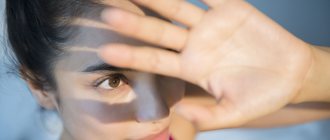Causes
The spread of the fear of hugs has been facilitated by the global migration of people from villages to cities. The townspeople lead an isolated lifestyle psychologically. Everyone around the city is strangers. Potentially dangerous. And people are increasingly becoming afraid of being touched.
Haptophobia can be caused by sexual violence. A person becomes asexual, hostility appears, personal space increases. And I don’t want to let others into it.
Often haptophobia is a consequence of another disorder:
- obsessive-compulsive disorder;
- anxiety disorder;
- mysophobia;
- diseases of a physiological nature: mental retardation, dementia, autism;
- catatonic manifestations of schizophrenia;
- Agaraphobia;
- paranoid mental disorder.
Haptophobia occurs in boys during adolescence. This is due to uncontrolled erection. It occurs when accidentally touching, shaking hands, or hugging. This could be an adult woman, a classmate, a sister. Physically this is natural and normal. But it brings a lot of worries. Because of this, teenagers try to avoid physical contact with others so as not to get into an awkward situation. The phobia may go away on its own or persist.
Tactilophobia is considered to be a synonym for haptophobia. It is worth noting that there is a slight difference between these concepts. Tactile phobes experience a fear of the touch of strangers.
What problems can be confused with haptophobia?
Not everyone who is touch intolerant suffers from haptophobia:
- Some people just have a very “wide” personal space. Such individuals do not tolerate familiar manners, literally keep everyone at arm's length, and try to avoid communication with unfamiliar people whenever possible;
- Also, the problem may be xenophobia, not haptophobia. Some individuals cannot tolerate the touch of representatives of races and ethnic groups that they consider “inferior” and hostile;
- Authoritarian individuals prone to perfectionism also often do not tolerate touch. For them, the highest ideal is order and cleanliness in everything, so they cannot tolerate friendly pats on the shoulder or other manifestations of informality and spontaneity;
Asexual people hate touch, since they associate tactile contact with physical intimacy.
Symptoms
Haptophobia manifests itself as anxiety during possible contact with others. A person, thinking that he will have to shake hands with strangers, experiences fear and tries to avoid contact at all costs.
Initially, a person who is afraid of touch reacts this way only to strangers. Touching loved ones does not cause a negative reaction. As the disease progresses, the person increasingly strives to isolate himself. He forbids anyone from entering his room and stops contacting others. The result is complete isolation. A person can no longer tolerate living together, even with loved ones. Breaks all social contacts.
In addition to psychological discomfort, haptophobia has physical (vegetative) manifestations:
- trembling in the arms, legs, neck;
- weakness, lightheadedness, faintness;
- dizziness;
- tingling in the limbs;
- dyspnea;
- palpitations, rapid pulse;
- nausea.
In severe cases, vomiting may occur. The autonomic system reacts differently for everyone. It depends on the characteristics of the body and on the cause of haptophobia.
External factors in a phobia
Medical and social workers have a fear of being touched by others. Every day they have contact with drug addicts and unkempt homeless people. Gradually, more and more fears regarding disease and dirt appear. They have an obsession that people carry bacteria and viruses. A mild form of disgust easily turns into a phobia.
In addition, phobia is one of the symptoms of mental retardation and autism. Fear of touch is closely related to a focus on one's own inner world. They perceive aggressively the attempts of others to penetrate their comfort zone.
Fear of other people's touches is diagnosed in people with nervous disorders. For example, these may be obsessive states and psychasthenia. They don't want to come into contact with strangers or even relatives because they think they might pick up bacteria. For such individuals, it is important to monitor their own hygiene and cleanliness. They always have wet wipes and antiseptics with them, so they react quickly and sharply to dirt and stains.
For some people, the smell of the interlocutor acts as an irritating factor. It can be repulsive and cause negative emotions. The aroma often evokes associations with the past. You just need to stop communicating with such a person for a certain period of time. There is no need to be too nice and polite.
How to recognize a haptophobe
For a person with a fear of touch, physical contact is like an electric shock. He subconsciously feels threatened. Therefore, if you extend your hand, the person will not return the handshake. He may turn around and leave if he sees someone coming to say hello.
Such people rarely go out and avoid public transport, cinemas, and shops. They try to keep their distance when talking to someone. Some people wear gloves to avoid touching their body.
A person suffering from haptophobia will immediately wash his hand and wipe it with a napkin if he has touched someone. This is not disgust - this is a mental disorder. He needs to clear the surface from the touch of a stranger. And such a person can be strangers to everyone except his own wife and children, or just everyone.
If there is a haptophobe among your friends, you should not be offended by his actions. The person has no intention of offending anyone, he has a mental disorder, he needs help. Isolation in the case of haptophobia only makes the problem worse. Therefore, he needs communication, support from family and friends.
A typical behavior for a person with a fear of being touched is to wear closed clothing. Even on hot summer days, preference is given to trousers, long skirts, and long-sleeve sweaters. This is a subconscious desire to protect yourself from possible touches. This makes the haptophobe feel more comfortable.
Features of fear of human touch
Suffering from haptophobia:
- tries to avoid communicating with unfamiliar people. Does not enter elevators, rarely travels by public transport, is an infrequent visitor to shops;
- hates any touch - handshakes, friendly pats on the shoulder, hugs. Even when communicating with good friends. The exception is close relatives.
If everything is left to chance, haptophobia will progress. Gradually, a person will become unbearable to be touched even by loved ones. This will destroy personal life and lead to isolation. A person suffering from haptophobia may stop communicating with people and turn into a recluse.
Impaired social interaction
Haptophobia forces a person to isolate himself from the company of other people. Alone, the “patient” is calmer. Over time, he becomes more and more withdrawn, because we all strive to protect ourselves from danger and find spiritual comfort. Also haptophobes. But their concept of safety and comfort is distorted. For them it is the absence of touching. No potential danger. Lack of people nearby.
This problem often makes it impossible to work and communicate. A person leaves a place of work where he needs to constantly interact with others. He becomes withdrawn, and this negatively affects the psyche. For mental balance, a person needs communication, communication, interaction. This is how we are made.
How to react to someone with a similar phobia
Some practical tips for people surrounded by hapnophobes.
Firstly, you should never overreact and be offended if even your loved one flinches from your touch, goes to wash his hand thoroughly, or directly asks you not to touch him. From the outside, all this may seem like impoliteness combined with a bad character, but you need to understand that for the haptophobe himself, touch can be so unbearable that he simply cannot control himself.
Secondly, it is necessary to consider the haptophobe’s reluctance to make tactile contact as simply stricter personal boundaries. For example, you can easily hug a person, but you will not share a toothbrush with him. Your comfort zone will not be violated by hugs, but anything else is no longer acceptable for you.
Many people can drink from the same bottle with a whole group, but for some this is completely unacceptable.
Different boundaries, different degrees of disgust - all this is individual. And if, even more so, a diagnosis of haphephobia is made, it is necessary to treat it with understanding.
In order not to create unpleasant situations, a professional psychotherapist will never offer his hand first for a greeting handshake with his client. Precisely because before the start of the session it is not known exactly what problems a person has and it is quite likely that it will be a fear of touching.
Diagnostics
If a person notices symptoms of haptophobia, he will have to see a doctor to confirm the diagnosis. It is impossible to diagnose yourself, just as it is impossible to get a haircut, cut out an appendix, or heal a tooth on your own. Entrust your health to a professional - a person who has studied psychology for many years. This could be a psychotherapist, psychiatrist, neurologist.
Fear of touch is diagnosed using special questionnaires and tests for various disorders. Remember: most often, haptophobia is not an independent illness. This is a “component” for another, more serious mental disorder.
One way or another, you shouldn’t be afraid of such symptoms. Psychology is actively developing, and all ailments are treatable.
Ways to overcome
Breathing exercises and various relaxation methods are used
to manage anxiety and panic attacks . Focusing on long, deep breaths reduces symptoms of touch anxiety. Mindfulness tactics, that is, understanding your thoughts and feelings at the moment of touch, help you develop individual ways to combat anxiety. Exercise and getting enough sleep are powerful ways to improve your overall mental health.
Patients with aphenphosmophobia generally respond well to treatment. Using daily techniques to overcome fear significantly reduces the negative impact of a phobia on a person’s life.
0
Treatment
Psychotherapy uses several different treatment models, alternating them for greater effectiveness:
- group therapy;
- cognitive behavioral therapy;
- drug therapy;
- hypnosis;
- psychoanalysis.
Medicines are prescribed to eliminate the physiological manifestations of the disease. The doctor will prescribe them based on the general picture of the disease.
Never prescribe medications for yourself!
Other methods aim to change negative associations associated with touch. Your doctor will help you understand that touching is safe and pleasant. Tactile contacts are necessary for every person for normal psychological health.
Psychologists advise hugging 3 to 8 people a day. This will help you get rid of depression, relieve stress, and improve your mood. Having haptophobia in a person alters this process. A person first needs to get rid of false fears and distorted reflexes associated with touch. For a haptophobe, such a number of hugs per day will most likely cause a panic attack. At the same time, the internal, subconscious need for hugs still remains, but it is not possible to satisfy it.
What can you do yourself?
If you are unable to contact a psychotherapist, you can use the helpline. Psychologists answer calls. Every city has a psychological support service. They will listen and give advice.
What else can you do?
- All alone, take a sheet of paper (use an electronic notepad, Word) and write down all the traumatic situations. Starting from early childhood.
- Reassess each situation and explain the reasons for what happened. Rethink.
- It is necessary to attach positive images and memories to each event. You must understand that what happened was an experience, and the reaction could have been softer, without injury. Find the positives.
- After that, look at each situation again. Emotions must change.
- Tear the paper or erase what you wrote. This is not in the present, these situations are in the past. And they won't happen again. Forget about them.
Remember that a lot of baggage from the past will slow you down on your path to the future. Let go of everything unnecessary. And think positive.
Advice from psychologists
The symptoms of thixophobia bring significant discomfort to the owner of the disorder. Thixophobes avoid public places, large crowds of people and events where frequent hugging and contact with people is necessary. In a situation where an unexpected touch occurs, thixophobe may exhibit inappropriate reactions from a panic attack to an outburst of uncontrollable anger. Psychological symptoms include physical ailments in the form of rapid pulse, pale or reddened skin color and trembling throughout the body. To alleviate symptoms and begin recovery, psychologists recommend:
Recognize the presence of a disorder. It can be difficult to admit that some experiences are out of control. It can be especially difficult to share your fears regarding objects that bring you to the peak of emotionality and interfere with your life. It is very important to do this, since without awareness of the problem it is almost impossible to take a step towards correction.
Find a possible cause. There is a problem in independently searching for causes, since many traumatic events are erased from memory and sent to storage in the unconscious. However, some patients bravely find in their memory the event that became a turning point. After this, it is important to look at the situation through the eyes of an adult and try to find an explanation for your feelings.
Warn loved ones. This will help avoid breaking relationships and misunderstandings on the part of people around you. For many people, tactile contact is a sign of attention and trust. Due to their ignorance, they may unconsciously constantly seek physical contact, from which thixophobe falls into horror. An explanatory conversation will help achieve understanding and comfort for a larger number of people around you.
Meditation and breathing. Any phobia is accompanied by increased anxiety. This leads to chronic fatigue and a pessimistic outlook on life. Meditation helps you find inner peace, improves sleep and can at least temporarily stop the flow of restless thoughts. Meditation is a way to become more aware of your feelings and emotions. This helps you monitor your condition and direct your thoughts in the right direction.
Contact a specialist. All of the above techniques can help in the early stages or mild forms of the disorder. But, if the situation gets out of control, the reasons are not found, and the symptoms are overwhelming, you need to go to a psychologist or psychotherapist. With the help of psychoanalytic psychotherapy, finding out the reasons with the help of leading questions and observation by a specialist, you can get rid of thixophobia.
Psychotherapy and its features
Drug therapy can only relieve some symptoms and prevent the development of possible complications, thereby alleviating the patient’s condition. But the fear of people’s touch is a pathology that develops and progresses over the years. To completely eliminate it, you need time and constant sessions with a psychologist.
To begin with, specialists, as a rule, draw up a scheme of individual lessons. The main goal of such sessions is to determine the root cause of the phobia. For example, sometimes a person needs to remember, realize and experience childhood trauma, get rid of feelings of guilt and wrong attitudes.
In the future, group classes will be useful. Working with a group of people helps the patient to grow above himself, to re-develop social communication and perception skills, and to adapt to being in society. If this gives positive results, then the doctor decides to conduct a kind of “shock therapy” - the patient must spend some time in a crowd of people, cope with his own sensations from touches and contacts.
Fear of other people's touches is a serious problem. Nevertheless, with a properly designed treatment regimen and constant work between the doctor and the patient, there is a chance to get rid of the phobia or at least make its manifestations more controllable.
What is haptophobia
Phobias can be very different; among the most “condemned” and “misunderstood” is haptophobia – fear of being touched. Fear is also often called aphephobia, haphophobia, haptephobia. This is a rather rare and specific phobia, which manifests itself as an obsessive fear of the touch of other people, a reluctance to contact them. The phobia manifests itself in psychasthenia or obsessive-compulsive disorder.
Haptophobia is an overly exaggerated sense of personal space. Every person has it, and everyone tries to protect it from the intrusions of strangers. However, in people whose psyche is disturbed, the boundary between personal and common space blurs, and the touch of strangers becomes more than unpleasant, and then a phobia appears. When a stranger “penetrates” personal territory, the feeling of discomfort intensifies to the limit, the fear of physical contact becomes uncontrollable.
In the modern world, intolerance to other people's touches is becoming so common that most people, including patients themselves, do not take it seriously. Although most often fear is only a side effect of a more serious illness, and it is treated after a person manages to cope with his neurosis.
The phobia can spread not only to strangers and random strangers, but also to family members and close friends. Often, fear of touch is mistaken for increased disgust, and as a result, resentment and misunderstanding arise; they react negatively to fear, without helping to overcome it with their support.
What could be the consequences?
In extreme cases, phonophobia can lead to misophonia, a hypersensitivity to sound. The term comes from the Greek words misos - “to hate” and phone - “sound”. The phobia is characterized by a sharply negative emotional reaction in response to certain sounds, for example, creaking doors, ticking clocks, footsteps, typing, loud breathing, slapping, squelching, sniffling, children crying, etc.
Disgust usually concerns sounds made by those closest to you. This condition was first described in 2000. An inadequate way to cope with this condition is the avoidance technique - using earplugs, listening to music through headphones to cut yourself off from unpleasant sounds.
This method can weaken social bonds and isolate and even increase the number of sounds that the patient cannot tolerate. Techniques used in tinnitus treatment and psychotherapy can improve quality of life in misophonia. Habituation therapy, also known as TRT training (Tinnitus Retraining Therapy), has shown good results. It consists in suppressing conditioned reflexes. It seeks to evoke pleasant associations with sounds that the patient finds unpleasant.
How does the disorder manifest?
One of the signs of OCD is severe, obsessive, frightening thoughts, images and desires, which are perceived by the human consciousness as meaningless and alien, but come to mind again and again. All attempts to resist such thoughts are in vain. The main “topics” of OCD are:
fear of becoming infected or contaminated; fear of harming others or oneself; violent thoughts and images; presentation of scenes of a sexual nature; religious ideas; moral beliefs; ideas that everything must be done “right”; excessive attention to superstitions.
Compulsive actions (rituals) are characterized by repeated actions that the patient performs over and over again in order to prevent some dangerous (in his opinion) but objectively unlikely event. Resistance to absurd obsessions and compulsions alien to consciousness overly exhausts a person and makes him suffer. Symptoms of OCD include:
- obsessive, constantly recurring thoughts;
- anxiety;
- certain repetitive actions performed to eliminate anxiety.
The most common example is the fear of contamination, in which the patient, if he touches a “dangerous” object, feels severe discomfort, accompanied by obsessive thoughts. To eliminate anxiety, the patient begins to wash his hands. If a “dirty” object is touched again, the hand washing ritual begins again. Another example is when patients, in order to make sure that the door to the apartment is really locked, pull the handle several times (while counting). These actions are protective and help the OCD sufferer to temporarily calm down. After them, patients feel that the threat has been “pushed aside” and move into a state that is acceptable to them, but after a while everything repeats itself. A person is fully aware of the meaninglessness of his behavior, but he is not able to fight such manifestations. In some situations, obsessive symptoms may intensify. For example, thoughts about harming oneself or others become even more intrusive when a person is in a room where there are knives or other sharp objects. To prevent an imaginary dangerous event, patients often perform actions that perform the function of magic spells. This can be the repetition of some phrases, reproduction (often mentally) of a certain melody, etc. Of particular importance is touching a particular object the “right” number of times. Such rituals represent an established, well-functioning system that usually exists for many years, although it is perceived by a person as something extremely tedious and meaningless.
As a rule, OCD sufferers try to hide their rituals; some patients consider such actions a sign of incipient madness. People with obsessive-compulsive disorder often involve other family members in their “ceremonies.” Relatives should not condone painful behavior; they should deal with such actions firmly, but with understanding and compassion.
Social phobia and sociopathy, what is the difference?
Because of the similar name, social phobia is often confused with sociopathy, but these are two different mental disorders.
Sociopathy is a dissocial personality disorder. Human behavior is antisocial. For people with dissocial disorder, their own desires come first; they do not feel obligated to do anything to others.
Unlike a social phobe, such a person does not avoid contact with other people and does not experience fear when communicating. Prone to impulsive actions and aggressive behavior. Sociopaths lack empathy, they do not feel guilt, they are not able to form attachments, the feelings and needs of other people are not important to them.
How to get rid of haptophobia
A psychotherapeutic conversation is used for diagnosis. During the conversation, the psychologist collects anamnesis, studies the client’s childhood history, looks for possible psychological trauma and causes of phobia.
During diagnosis, it is important to differentiate phobia from other disorders and fears. Based on the diagnostic results, the doctor selects treatment
Self-deliverance
To get rid of fear, you need to face it. Try taking a dance or acting class. It is necessary to visit crowded places more often, such as shopping centers or concerts. Pre-master self-regulation techniques, such as breathing exercises, and use them when fear occurs. You can tell your loved ones about your problem and ask for help in dealing with the phobia.
Psychotherapy
Fear of touch is a violation of social interaction. For treatment, psychotherapy, group classes and medication are used (if the phobia has a complicated course or has developed against the background of another disorder, as well as against the background of hormonal imbalance). In addition, cognitive behavioral psychotherapy, hypnosis, and psychoanalysis can be used.
In individual or group sessions, patients talk about their fears and emotions, their vision of the causes and course of the phobia. The psychologist asks leading questions and, if necessary, conducts additional testing. Gradually the patient is brought closer to frightening situations.










